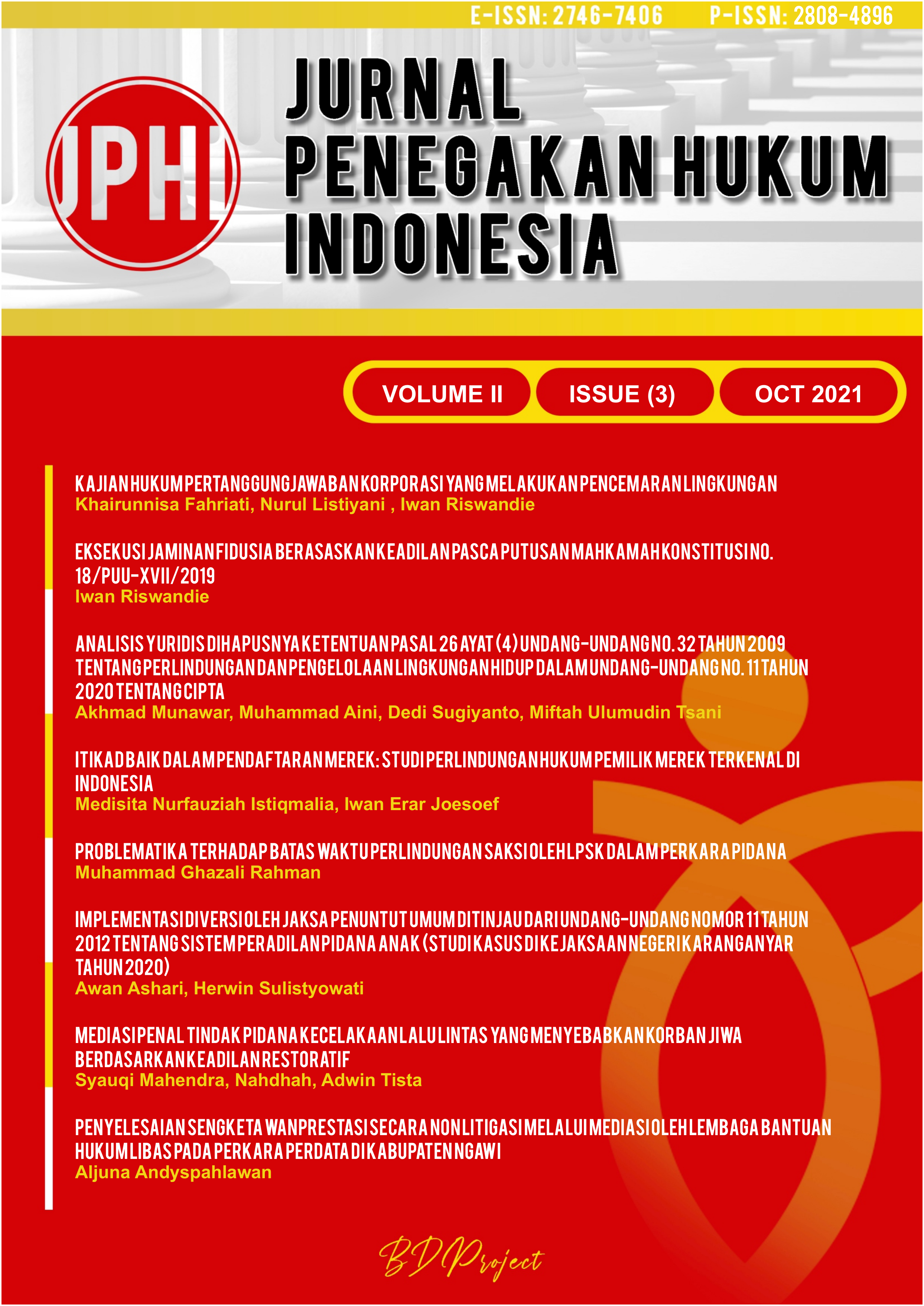Analisis Yuridis Dihapusnya Ketentuan Pasal 26 Ayat (4) Undang-Undang No. 32 Tahun 2009 Tentang Perlindungan Dan Pengelolaan Lingkungan Hidup Dalam Undang-Undang No. 11 Tahun 2020 Tentang Cipta
DOI:
https://doi.org/10.51749/jphi.v2i3.40Keywords:
Lingkungan Hidup, Cipta Kerja, Environment, Job CreationAbstract
The 1945 Constitution of the Republic of Indonesia Article 28 H paragraph (1) states that everyone has the right to live in physical and spiritual prosperity, to have a place to live, and to have a good and healthy living environment and have the right to obtain health services. After the enactment of the Employment Creation Law on October 5, 2020, the impact of changes to several provisions stipulated in the PPLH Law, including the part that was deleted was Article 26 paragraph (4) of the PPLH Law which reads "The community as referred to in paragraph (1) may file an objection to The AMDAL document” is also not accompanied by an explanation so that it can lead to confusion in what kind of society rejects the document, with the abolition of the provisions of Article 26 paragraph (4) of the PPLH Law, resulting in the community no longer having the right to file an objection to the environmental impact analysis document. alias Amdal on a project because their rights have been removed in the Job Creation Act. The formulation of the first problem in this study is how the legal consequences of the abolition of the provisions of Article 26 Paragraph (4) of Law no. 32 of 2009 concerning the Protection and Management of the Environment on the participation of the community in the supervision of a good and healthy environment. Furthermore, the formulation of the second problem is how the provisions in Article 26 paragraph (4) of Law no. 32 of 2009 concerning Environmental Protection and Management from the perspective of Human Rights in Article 28 Letter H Paragraph (1) of the Constitution of the Republic of Indonesia. This study uses a type of juridical-normative research because the problem will be analyzed by reviewing the laws and regulations relating to the abolition of the provisions of Article 26 paragraph (4) of Law Number 32 of 2009 concerning Environmental Protection and Management in Law Number 11 of 2020 on Job Creation.
References
Buku
Abdulkabir Muhammad, 2004, Hukum dan Penelitian Hukum, Bandung, Citra Aditya Bakti.
Abdurrahman, 2005, Pengantar Hukum Lingkungan Indonesia, Bandung: Alumi.
Agoes Soegianto, 2010, Ilmu Lingkungan, Sarana Menuju Masyarakat Berkelanjutan, Surabaya, Airlangga University Press.
M. A.S. Hikam, 1999, Politik Kewarganegaraan, Jakarta, Erlangga.
Mukti Fajar ND dan Yulianto Achamd, 2010, Dualisme Penelitian Hukum, Normatif dan Empiris, Yogyakarta, Pustaka Belajar.
Muladi. 2009. Hak Asasi Manusia- Hakekat, Konsep, & Implikasinya dalam perspektif hukum & Masyarakat. Bandung, PT. Refika Aditama
Nurul Listiyani, 2017, Pengelolaan Lingkungan Hidup yang Berkelanjutan Dalam Pemanfaatan Sumber Daya Batubara. Banjarbaru, Penakita Publisher.
Otto Soemarwoto, 2001, Ekologi Lingkungan Hidup, Jakarta, Djembatan.
Undang-Undangan
Undang Undang Dasar Negara Republik Indonesia Tahun 1945.
Undang Undang Nomor 32 Tahun 2009 tentang Perlindungan dan Pengelolaan Lingkungan Hidup.
Undang Undang Nomor 11 Tahun 2020 tentang Cipta Kerja.
Jurnal
Fola S. Ebisemiju, Environmental Impact Assessment: Making it Work in Developing Countries, Journal of Environmental Management.
Nurul Listiyani, Dampak Pertambangan Terhadap Lingkungan Hidup di Kalimantan Selatan, dan Implikasinya Bagi Hak-Hak Warga Negara.
Lalu Sabardi, Peran Serta Masyarakat dalam Pengelolaan Lingkungan Hidup menurut Undang-Undang Nomor 32 Tahun 2009 Tentang Perlindungan dan Pengelolaan Lingkungan Hidup. Yustisia Vol. 3 No. 1 Januari - April 2014.
Internet
Denny Susanto, “Sungai Amandit Kalsel Tercemar Tambang, https://m.mediaindonesia.com/read/detail/241462-sungai-amandit-kalsel-tercemar-tambang
Downloads
Published
How to Cite
Issue
Section
License
Copyright (c) 2021 Akhmad Munawar, Muhammad Aini, Dedi Sugiyanto, Miftah Ulumudin Tsani

This work is licensed under a Creative Commons Attribution-NonCommercial-ShareAlike 4.0 International License.
JPHI is licensed under a Creative Commons Attribution-NonCommercial-ShareAlike 4.0 International License
Articles in JPHI are Open Access articles published under the Creative Commons CC BY-NC-SA License. This license allows reusers to distribute, remix, adapt, and build upon the material in any medium or format for noncommercial purposes only, and only so long as attribution is given to the creator. If you remix, adapt, or build upon the material, you must license the modified material under identical terms.











